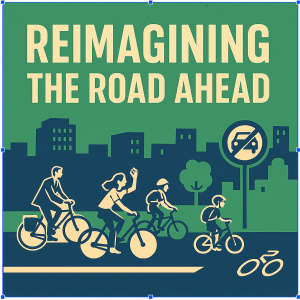
Wednesday Jun 25, 2025
Reimagining the Road Ahead
"Reimagining the Road Ahead" delves into the concept of car-free days, especially their implementation in Bogotá and Paris, the political and practical challenges to their widespread adoption, and the broader push to re-imagine urban spaces with fewer cars.
Enrique Peñalosa is a Colombian politician and urban strategist who served as mayor of
Bogotá (1998–2000, 2016–2019). He is known for championing sustainable urban mobility,
including Bogotá’s TransMilenio bus system and the city’s first Día Sin Carro (Car-Free Day), a
bold initiative that reshaped public attitudes toward transportation and urban space. His policies
prioritized pedestrian and cycling infrastructure, aiming to create a more equitable and
accessible city.
https://en.wikipedia.org/wiki/Enrique_Pe%C3%B1alosa
Daniel Rich is a former local government manager with over 30 years of public sector
experience. He served as Mountain View’s City Manager from 2011 to 2019, overseeing
complex land use projects and regional planning efforts. Earlier in his career, he held leadership
roles in Sunnyvale, Belmont, and Campbell, as well as working for members of Congress. Since
retiring, he has been a lecturer at Stanford University, teaching courses on public policy and
local government
https://urbanstudies.stanford.edu/people/daniel-h-rich
Dehan (Danno) Glanz is an urban designer and planner with expertise in transit-oriented
development. His work spans large-scale village design, architectural prototypes, and
mixed-use neighborhoods that integrate sustainable transportation. He has contributed to
projects such as the Hunters Point Naval Shipyard Re-Use Plan and the Richmond BART
Transit Village. Glanz holds a BA in Urban Studies from Stanford University and a Master of
Architecture from UCLA. (Though not in our podcast, his interview helped our group refine our
scope early in production).
https://urbanstudies.stanford.edu/people/dehan-danno-glanz
Music
Artist | Song Title | Source (in order of appearance)
Carlos Vives | Ella Es Mi Fiesta | YouTube
Greenfire | False Records | Blue Dot Sessions
Jon Presstone | The Nature of Curiosity | YouTube
Desjardins | The Maison | Blue Dot Sessions
Azalai | Taoudella | Blue Dot Sessions
Bodytonic | Thannoid | Blue Dot Sessions
Maurice Larcange | Traditionnel musette | YouTube
Stromae | Alors on danse | YouTube
Glass Obelisk | First Results | Blue Dot Sessions
Eltham House | Delicates | Blue Dot Sessions
The Fence | Bivly | Blue Dot Sessions
Atlas of Urban Expansion - Los Angeles. (n.d.).
http://www.atlasofurbanexpansion.org/cities/view/Los_Angeles This online resource provides detailed spatial and statistical data on the urban expansion of Los Angeles, emphasizing the city's extensive growth and sprawling road
networks. It highlights how urban development patterns have shaped car-centric land use and transportation infrastructure.
Chrisafis, A. (2015, September 27). All-blue skies in Paris as city centre goes car-free for first
time. The Guardian; The Guardian.
https://www.theguardian.com/cities/2015/sep/27/all-blue-skies-in-paris-as-city-centre-goes-car-free-for-first-time
Glazener, A., Wylie, J., Van Waas, W., & Khreis, H. (2022). The impacts of Car-Free Days and
events on the environment and human health. Current Environmental Health Reports,
9(2), 165–182.
This peer-reviewed study reviews global evidence on how car-free events affect air pollution levels and public health, with findings that support reduced vehicular traffic as a means to improve urban environmental conditions. The authors also explore limitations and recommendations for future policy design.
https://urban-mobility-observatory.transport.ec.europa.eu/news-events/news/identifying-amount-urban-space-occupied-roads-2021-06-21_en
This article examines how much of a city's surface area is allocated to road infrastructure, highlighting the implications for urban planning and sustainability. It underscores the need to reevaluate space usage in cities dominated by car-centric designs.
Masiol, M., Agostinelli, C., Formenton, G., Tarabotti, E., & Pavoni, B. (2014). Thirteen years of air pollution hourly monitoring in a large city: Potential sources, trends, cycles and effects of car-free days. The Science of the Total Environment, 494–495, 84–96.
https://doi.org/10.1016/j.scitotenv.2014.06.122
Based on over a decade of air quality monitoring, this study analyzes pollution patterns and confirms measurable air quality improvements during car-free days. It offers valuable data for policymakers aiming to implement sustainable transportation strategies.
https://doi.org/10.2753/atp1084-1806310201
Mercier explores the intersection of transportation planning with equity and social justice, arguing for inclusive policies that consider marginalized communities. The article critiques conventional transportation systems and proposes frameworks for more equitable urban mobility.
Paris Journée sans Voitures. (2015, October). Soundlandscapes’ Blog.
https://soundlandscapes.wordpress.com/2015/10/01/paris-journee-sans-voitures/
This blog post offers a personal narrative and sound-based exploration of Paris's car-free day, capturing the unique urban atmosphere when motor traffic is halted. It complements academic studies with experiential insight into public reactions and sensory transformations.
Potter, B. (2023, August 10). How the Car Came to LA. Construction Physics.
https://www.construction-physics.com/p/how-the-car-came-to-la
Potter provides a historical analysis of how Los Angeles developed its car-dominated infrastructure, explaining economic, political, and cultural factors. The article contextualizes current urban form and mobility issues in the city’s past transportation choices.
Statista. (2025, April 28). Transportation sector CO₂ emissions in the U.S. 1975-2024.
https://www.statista.com/statistics/1118464/transportation-co2-emissions-in-the-us-energy-consumption/#:~:text=U.S.%20transportation%20sector%20emissions%20from,percent%20of%20the%20global%20total.
This statistical source charts U.S. transportation-related CO₂ emissions over five decades, illustrating trends and contributing factors. It serves as a key reference for understanding the environmental footprint of vehicular travel.
The Paris Agreement and uncertainty in the warming from 1850-1900 to recent decades. (n.d.).Copernicus.
https://climate.copernicus.eu/GCH2023-Paris-Agreement
This article discusses the scientific assessments underpinning the Paris Agreement targets, focusing on climate change baselines and projected temperature increases. It emphasizes the urgency of reducing emissions, including from transportation, to meet global climate goals.
UNFCCC. (2025). The Paris Agreement. United Nations Climate Change; United Nations.
https://unfccc.int/process-and-meetings/the-paris-agreement
This official UN source outlines the framework and commitments of the Paris Agreement,
aiming to limit global warming through national contributions and mitigation strategies. It provides the international policy context for local climate actions, including transportation
Urry, J., Leach, J. M., Dunn, N., Coulton, C., & Team, L. C. (2017). The little book of car free cities.
This publication presents a concise guide to envisioning and implementing car-free
urban environments, supported by case studies and design principles. It advocates for
reimagined cityscapes that prioritize people, sustainability, and public health over private
vehicle use.
No comments yet. Be the first to say something!